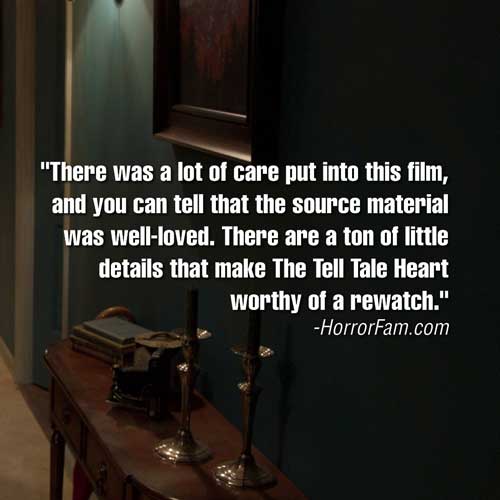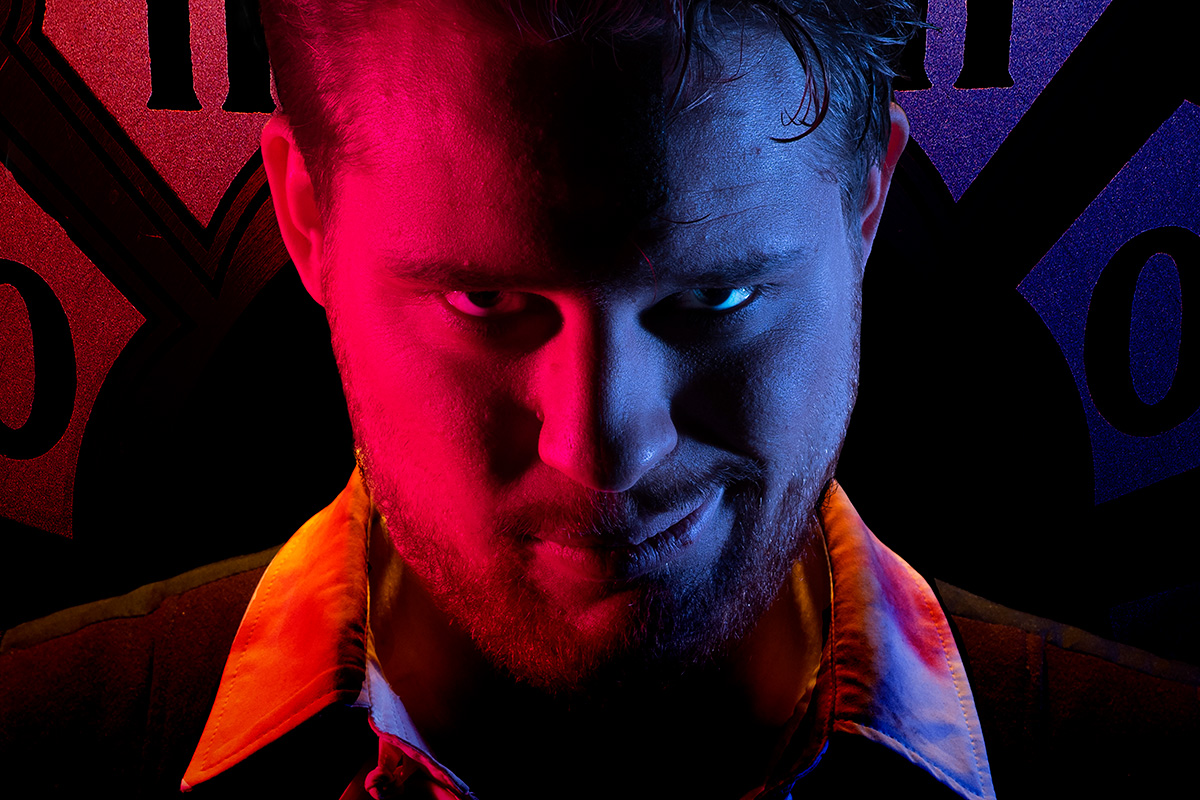
Horrorfam Review
By Lauren Spear
November 4, 2021

The Tell Tale Heart begins with a quote from American poet Henry Wadsworth Longfellow… An interesting choice, right off the bat, as ol’ Poe had an interesting history with Longfellow that was akin to, say, today’s YouTuber dramas or online influencer beefs. Was “The Longfellow War” and Poe’s plagiarism accusations against Longfellow genuine? Was it a publicity stunt to boost reader traffic to Poe’s publication? Or was the truth somewhere in the middle… or nowhere at all?
Within the first ten seconds of McClain Lindquist’s The Tell Tale Heart, with its oddly out-of-place (yet somehow deeply fitting) opening quote, lets you know that you’re about to go on a journey in which you’ll always feel just a tad bit unsure.
“We need the whole story,” a voice says, as the quote fades to a black screen.
Yes, we do! Here’s what I thought of this most-recent film adaptation of the Edgar Allan Poe classic short story.
The Whole Story: My Review of The Tell Tale Heart
If you’ve read Edgar Allan Poe’s The Tell Tale Heart, you already know what to expect. The short story has already been made into multiple films. It’s been parodied as well — so even if you’ve never read it, you probably feel like you have.
This puts the team behind the 2020 rendition of The Tell Tale Heart at both an advantage and a disadvantage out of the gate. They’re able to streamline the story, knowing that their audience will fill in any gaps (like I said, even if you’ve never read Poe’s work, you know it — like a song you know the beat to, if not the lyrics); but, if they stray too far from the source material, Poe fanatics may get uppity.
But they do have to stray a little, don’t they? If not, this newest adaptation would have nothing to offer us as viewers. If you were happy eating Crunch bars, why would you bother eating a Krackel bar? They’re both milk chocolate with crunchy rice bits, right? The answer is the ratio! Krackel was deemed more delicious than Crunch because the ratio of chocolate-to-rice was superior, delivering a more powerful, more memorable flavor.
Was McClain Lindquist’s The Tell Tale Heart able to strike that balance? Did this film find the ratio between same ol’ chocolate Poe that everyone knows and fresh, crackling bits of new?
Yes. It did.
It was a nice lil treat.
What I Liked About McClain Lindquist’s The Tell Tale Heart:
There was a lot of care put into this film, and you can tell that the source material was well-loved. There are a ton of little details that make The Tell Tale Heart worthy of a rewatch. For example, at around the 10-minute mark, the camera zooms in on a nightstand and you can see pill bottles from Usher Family Pharma and Gold Bug Pharmacy — nods to Edgar Allan Poe’s “The Fall of the House of Usher” (1839) and “The Gold-Bug” (1843) respectively.
I also loved all of the practical effects! Chris Hanson (and crew?) did a wonderful job. The visuals in general were very nice and I’d love to see Lindquist and Hanson team up again to do some sort of horror-centric music video!
Newcomer Sonny Grimsley did a fine job as the main character (and had that tell-tale – hah! – smirk everyone seems to get when successfully reading Poe aloud), Mikah Olsen and Teren Turner were great as the law enforcement officers investigating the narrator’s crime (Olsen was especially good and said so much with her facial expressions), and James C. Morris was fab as the old man.
As for the film itself… The closest thing I can think to compare this version of The Tell Tale Heart to is Romeo + Juliet.
Remember when Romeo + Juliet came out in 1996 and people were like “What the heck? Everything is super modern and totally ‘90s, but all the actors are talking all Shakespeare-y!” McClain Lindquist’s adaptation of Edgar Allan Poe’s The Tell Tale Heart is a lot like that.
The bulk of the dialogue, delivered by Sonny Grimsley as the narrator, is straight from the original story. It sounds very old-timey and weird. But the visuals (and lines delivered by supporting characters) are all very modern.
That doesn’t always work and I was admittedly wary at first. However, I think that the odd contrast did work in this case because it added an extra layer of discomfort. It helped remind me that this short story from the 1800s was, indeed, a horror story!
Poe’s work has been around for so gosh darn long that I think many of us have become a bit numb to it. I was given one of those “complete collection” books of Poe’s stories as a tween and was a bit settled into the idea that his words were tame. Not so! Director (and screenplay writer/adapter) Lindquist may have set the story in modern times, but the overall adaptation was extremely literal and pulled straight from the original texts — and the result is hardcore.
When you read or listen to Edgar Allan Poe’s words alone, it’s easy to feel detached from it. Lindquist’s film was a great reminder that dismembering a body in a bathtub is — and always was — a grisly affair. Messy. Gross.
Much like Romeo + Juliet is used to get resistant high schoolers into Shakespeare, I could easily see McClain Lindquist’s The Tell Tale Heart being used to get today’s teenagers into Poe.
What I Disliked About the Film:
There were a few moments that pulled me out of the film. The biggest one was when the detective said, “He likes his room kept this dark? It’s pitch black in here!” when questioning the narrator in regard to his master’s chambers.
I got a bit derailed due to my confusion and had to stop and rewind to get back on track. The room in question was more well-lit than my own! It had a lovely open window with plenty of natural lighting…
I thought, perhaps, I was seeing a bright room because the unreliable narrator was seeing a bright room and he was the one in charge of what I was seeing, but then the narrator also commented on the darkness of the room so then I just felt kinda sad like, “If that’s what’s considered ‘pitch black’ then what kind of utter darkness am I residing in? Do we need a lamp? Wait. We have a lamp but the bulb burnt out… Why didn’t we buy a new bulb?? Do they still make compatible bulbs for that lamp? What happened to the sun? Is winter over yet? What do you mean winter hasn’t even started yet?! Ughhhh… Why…”
But, since the original story also mentions that the room is dark, and the film’s bedroom does appear a teeny bit darker in the glimpses of reality we’re shown (but still very light!), I have a feeling that it was just a small lighting issue in the film rather than a story element. Which was jarring to realize because the film is so well done overall that you kind of forget that it’s an indie film made by a first-time filmmaker!
So, basically, they came in so strong that my expectations were immediately raised above the usual indie film level, but sometimes there were little itty-bitty things that weren’t ultra-polished (like the lighting thing, or a line delivery, etc.) that made me go “HUH?! Oh wait. Yeah. Indie film. I forgot. Carry on then.” (And, honestly, I think most viewers wouldn’t even notice/mind the itty-bitty things… I just get hyperfixated on stuff).
My only other “dislike” is that the screener I watched didn’t have any closed captions. Which, I guess, is pretty typical for a theater-like experience… But I don’t miss theaters. Closed Captions are a pain in the butt to create (I had to write some recently for a video I made), but they’re super important.
However, given the amount of care this team put into making their film, I have high hopes that the official/home release will have CC included! The press kit mentions English subtitles so it’s highly likely that the final version already has that issue taken care of.
Final Thoughts: Go Watch The Tell Tale Heart
I’m always reluctant to do reviews and vastly prefer when someone else steps up to write them instead. But, sometimes, I’m either requested personally (why?!) or I’m the only person available (far more likely hahaha).
Reviews (as well as everything else) are especially difficult for me to do in colder weather. I never ever want my own seasonal anhedonia to crush someone else’s creative dreams, y’know? I always fear my own mood (or lack thereof) will color my opinion of someone else’s art.
Like… How many negative film reviews have been given simply because the critic was constipated that day? Or because they didn’t get enough sleep? Or because the theater was bone-chillingly cold and the person next to them kept making uncomfortably loud slurping noises while scarfing down their deluxe-size nachos with extra queso?? I mean, that last one was a very specific scenario (that’s far less likely in the new age of home streaming), but it COULD happen! And it could result in a pre-disgruntled critic viewing a film through pessimistic eyes… and being far harsher than necessary.
Then again, viewing a film when you’re exceptionally happy can make a critic a lot more forgiving! As can watching something with friends (everything is better when you’re with your friends).
Anyway, that was all just a long-winded ramble to say that when I view films for review purposes, I do my very best to watch them when I’m in a neutral mood (but not apathetic — just kinda mildly pleasant but not numb; but not too happy or too grumbles either) and I watch them alone (so as not to be influenced by others, at least on the first viewing). I try very very hard to be fair.
But, in the end, none of that REALLY matters because it’s still just MY opinion! And not to knock me or anything (I’m pretty okay!) but the opinion that really matters here is your own. If this film — or any other film — sparks your interest, then you should check it out!
In the case of McClain Lindquist’s The Tell Tale Heart, this is all the more applicable — after all, at only 22 minutes long, what do you have to lose?? If you have the opportunity to watch it, set aside one-third of an hour and do so.
Check out their website at TellTaleMovie.com or follow them on Twitter @TellTaleFilm for updates about when/where you can watch The Tell Tale Heart.
Review can be found at: https://horrorfam.com/the-tell-tale-heart-2021-review/
